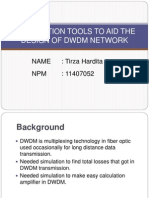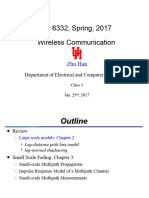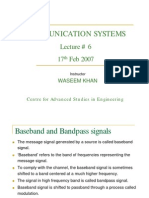0 ratings0% found this document useful (0 votes)
5 views7 - WC - Markov - Model - Power - Delay - Profile
7 - WC - Markov - Model - Power - Delay - Profile
Uploaded by
anand.naman69The document discusses finite-state Markov channels as a simpler model for capturing the main features of flat fading channels needed for analytical wireless performance analysis. It models fading as a discrete-time Markov process over a set of finite channel states with transition probabilities between states. It also discusses power delay profiles which give the intensity of a signal through a multipath channel as a function of time delay.
Copyright:
© All Rights Reserved
Available Formats
Download as PPTX, PDF, TXT or read online from Scribd
7 - WC - Markov - Model - Power - Delay - Profile
7 - WC - Markov - Model - Power - Delay - Profile
Uploaded by
anand.naman690 ratings0% found this document useful (0 votes)
5 views5 pagesThe document discusses finite-state Markov channels as a simpler model for capturing the main features of flat fading channels needed for analytical wireless performance analysis. It models fading as a discrete-time Markov process over a set of finite channel states with transition probabilities between states. It also discusses power delay profiles which give the intensity of a signal through a multipath channel as a function of time delay.
Original Description:
Markov model- power delay Profile
Original Title
7_WC_Markov_Model _ Power_Delay_Profile
Copyright
© © All Rights Reserved
Available Formats
PPTX, PDF, TXT or read online from Scribd
Share this document
Did you find this document useful?
Is this content inappropriate?
The document discusses finite-state Markov channels as a simpler model for capturing the main features of flat fading channels needed for analytical wireless performance analysis. It models fading as a discrete-time Markov process over a set of finite channel states with transition probabilities between states. It also discusses power delay profiles which give the intensity of a signal through a multipath channel as a function of time delay.
Copyright:
© All Rights Reserved
Available Formats
Download as PPTX, PDF, TXT or read online from Scribd
Download as pptx, pdf, or txt
0 ratings0% found this document useful (0 votes)
5 views5 pages7 - WC - Markov - Model - Power - Delay - Profile
7 - WC - Markov - Model - Power - Delay - Profile
Uploaded by
anand.naman69The document discusses finite-state Markov channels as a simpler model for capturing the main features of flat fading channels needed for analytical wireless performance analysis. It models fading as a discrete-time Markov process over a set of finite channel states with transition probabilities between states. It also discusses power delay profiles which give the intensity of a signal through a multipath channel as a function of time delay.
Copyright:
© All Rights Reserved
Available Formats
Download as PPTX, PDF, TXT or read online from Scribd
Download as pptx, pdf, or txt
You are on page 1of 5
Finite –State –Markov -Channels
The complex mathematical characterization of flat
fading can be difficult to incorporate into wireless
performance analysis
simpler models that capture the main features of flat
fading channels are needed for these analytical
calculations.
One such model is a finite state Markov channel
(FSMC).
In this model fading is approximated as a discrete-
time Markov process with time discretized to a given
interval T (typically the symbol period)
the set of all possible fading gains is modeled as a set
of finite channel states.
The channel varies over these states at each interval
T according to a set of Markov transition
probabilities.
FSMCs have been used to approximate both
mathematical and experimental fading models,
including satellite channels ,indoor channels ,
Rayleigh fading channels ,Ricean fading
channels ,and Nakagami-m fading channels.
The transition probabilities between regions are
the region boundaries
{Aj}
Power delay profile
The power delay profile (PDP) gives the
intensity of a signal received through a multipath
channel as a function of time delay.
The time delay is the difference in travel time
between multipath arrivals.
In the graph of the PDP abscissa represents units
of time whereas ordinate is usually in decibels.
It can be measured empirically and can be used to
extract certain channel's parameters such as the
delay spread.
Power delay profile graph….
-90
RMS Delay Spread () = 46.4 ns
-90
Received Signal Level (dBm)
Mean Excess delay () = 45 ns
-95
Maximum Excess delay < 10 dB = 110 ns
-100
Noise threshold
-105
0 50 100 150 200 250 300 350 400 450
Excess Delay (ns)
You might also like
- Lecture Notes 5 Part2Document21 pagesLecture Notes 5 Part2Huseyin OztoprakNo ratings yet
- Basics of Small Scale Fading: Towards Choice of PHYDocument18 pagesBasics of Small Scale Fading: Towards Choice of PHYtazebNo ratings yet
- Mobile Radio Propagation: Small-Scale Path Loss: EENG473 Mobile Communications Module 3: Week #Document76 pagesMobile Radio Propagation: Small-Scale Path Loss: EENG473 Mobile Communications Module 3: Week #Eyob TadesseNo ratings yet
- Examples FadingDocument7 pagesExamples FadingPrabhat SinhaNo ratings yet
- Bandpass Signals and SystemsDocument25 pagesBandpass Signals and SystemsprincyNo ratings yet
- l3 - Part1 - Analog Front End Sampling - v22Document31 pagesl3 - Part1 - Analog Front End Sampling - v22Pham Xuan ThuyNo ratings yet
- Spectral Leakage in The Discrete Fourier Transform: Greg Adams, LMCO MS2, 4/10/07Document31 pagesSpectral Leakage in The Discrete Fourier Transform: Greg Adams, LMCO MS2, 4/10/07nctgayarangaNo ratings yet
- A Simulation Tools To Aid The Design of DWDM Network: Name: Tirza Hardita NPM: 11407052Document15 pagesA Simulation Tools To Aid The Design of DWDM Network: Name: Tirza Hardita NPM: 11407052hasNo ratings yet
- EE6332 Class3Document39 pagesEE6332 Class3amithreddy2662No ratings yet
- Flex Max FM331-LE 1 GHZ Line Extender Amplifier Data SheetDocument5 pagesFlex Max FM331-LE 1 GHZ Line Extender Amplifier Data SheetJustin OlssonNo ratings yet
- Review IDocument8 pagesReview IdioumbNo ratings yet
- HFC NetworksDocument5 pagesHFC NetworksNormandy Martinez LucianoNo ratings yet
- Extra ExercisesDocument11 pagesExtra ExercisesPhước Lê Trần Vĩnh (41901018)No ratings yet
- Feature Extraction MFCCs PDFDocument15 pagesFeature Extraction MFCCs PDFpkrsuresh2013No ratings yet
- Experiment Number 10 Pre-Emphasis and De-Emphasis NetworksDocument2 pagesExperiment Number 10 Pre-Emphasis and De-Emphasis NetworksRahul SrivastavaNo ratings yet
- ION-B DAS CommissioningDocument15 pagesION-B DAS Commissioningacouch88No ratings yet
- Lecture 6Document16 pagesLecture 6api-3702538No ratings yet
- IQxel TechSpecs 081915Document14 pagesIQxel TechSpecs 081915Vasikaran PrabaharanNo ratings yet
- Application of Butterworth Filter in Display of Radar Target TrackDocument3 pagesApplication of Butterworth Filter in Display of Radar Target TrackIra CervoNo ratings yet
- Power Delay Profile Delay Spread Doppler Spread: by Manish SrivastavaDocument23 pagesPower Delay Profile Delay Spread Doppler Spread: by Manish Srivastava蘇菲和尚No ratings yet
- NT Old QuestionsDocument64 pagesNT Old QuestionsSomya SinghNo ratings yet
- Modul 1 - 4 Link BudgetDocument6 pagesModul 1 - 4 Link Budgetkadaparajshekarreddy987No ratings yet
- 4 ProcessingDocument117 pages4 ProcessingKHOA LE NGUYEN DANGNo ratings yet
- Mobile Radio Propagation: Small-Scale Fading and MultipathDocument88 pagesMobile Radio Propagation: Small-Scale Fading and MultipathKhyati ZalawadiaNo ratings yet
- Principles of Primary MUXDocument164 pagesPrinciples of Primary MUXVivek Kumar MNo ratings yet
- TLT-6406 Section 8Document53 pagesTLT-6406 Section 8Junaid JuttNo ratings yet
- LTE Link BudgetDocument7 pagesLTE Link BudgetChidhuro OwenNo ratings yet
- Procesamiento Digital de Señales: Jhon James Granada TorresDocument39 pagesProcesamiento Digital de Señales: Jhon James Granada Torresdavidt1516No ratings yet
- RecapitulationDocument55 pagesRecapitulationpatriciaruleNo ratings yet
- HW 2Document2 pagesHW 2roronoaNo ratings yet
- BodeDocument1 pageBoderina sita dewiNo ratings yet
- Analog RF & Microwave Signal Generation Output Power ConsiderationsDocument33 pagesAnalog RF & Microwave Signal Generation Output Power ConsiderationshocycnNo ratings yet
- HF Transmitter Jrs 900 JRCDocument2 pagesHF Transmitter Jrs 900 JRCtruongvietthien19No ratings yet
- Lecture 4 SystemDocument19 pagesLecture 4 SystemAhmed ShafeekNo ratings yet
- Chairs Be OhDocument29 pagesChairs Be OhAnand ReddyNo ratings yet
- Tracking of Time Hopped DS-CDMA Signals For Pseudolite-Based PositioningDocument15 pagesTracking of Time Hopped DS-CDMA Signals For Pseudolite-Based PositioningVenkata_Suryan_7431No ratings yet
- (RF회로 및 시스템 설계) 7.RF System Budgeting - v8Document57 pages(RF회로 및 시스템 설계) 7.RF System Budgeting - v8Ahmad BilalNo ratings yet
- Digital Representation of Audio InformationDocument22 pagesDigital Representation of Audio InformationYuaris ArhamNo ratings yet
- RF System (Link Budget) Calculations: System Variables Variable Units Equation ValueDocument11 pagesRF System (Link Budget) Calculations: System Variables Variable Units Equation ValueAbhishek SrivastavaNo ratings yet
- The GSM Radio LinkDocument34 pagesThe GSM Radio LinkS. Sayeed DipNo ratings yet
- Alcatel 9600LSYDocument2 pagesAlcatel 9600LSYsamiNo ratings yet
- Unit1 Small ScaleDocument36 pagesUnit1 Small ScaleloginmadeshwarNo ratings yet
- Lect03 Audio RepresentationDocument34 pagesLect03 Audio RepresentationEvan SumidoNo ratings yet
- 07 CM0268 DSPDocument58 pages07 CM0268 DSPjhovanhkNo ratings yet
- Unit07 ChanEstDocument40 pagesUnit07 ChanEsthimanshu.koley4897No ratings yet
- Specification of Dualband RF For VNPDocument3 pagesSpecification of Dualband RF For VNPThái DươngNo ratings yet
- Power Delay Profile: p (τ) multipath channelDocument5 pagesPower Delay Profile: p (τ) multipath channelAli MohamedNo ratings yet
- MCS Assignment2Document4 pagesMCS Assignment2mrwarda45No ratings yet
- Dtkom Line Broadband Multiband Amplifier: 1 Input: Vhf/Uhf/Sat + Return CHDocument2 pagesDtkom Line Broadband Multiband Amplifier: 1 Input: Vhf/Uhf/Sat + Return CHfenixconNo ratings yet
- CW LaserDocument3 pagesCW Laserm.irfanzaidi34No ratings yet
- NTE2696 Silicon NPN Transistor Low Noise Audio Amplifier TO 92 Type Package (Compl To NTE234)Document2 pagesNTE2696 Silicon NPN Transistor Low Noise Audio Amplifier TO 92 Type Package (Compl To NTE234)Esmir MarinNo ratings yet
- Exp - 9Document9 pagesExp - 9ponrajeshm.ug22.ecNo ratings yet
- Homework 3Document2 pagesHomework 3alma0abbNo ratings yet
- Chapitre 0: Wireless Channels Wireless ChannelsDocument14 pagesChapitre 0: Wireless Channels Wireless ChannelsSonia REZKNo ratings yet
- Adcs Fast Fourier Transforms and Windowing Presentation QuizDocument21 pagesAdcs Fast Fourier Transforms and Windowing Presentation QuizffffNo ratings yet
- SPM Vibration AnalysisDocument74 pagesSPM Vibration Analysissyarafunnisa85No ratings yet



























































